

Blue fescue is a cute little blue grass, great for landscaping.
A summary of blue fescue facts
Name – Festuca glauca
Family – Poaceae
Type – perennial, grass
Height – 12 to 20 inches (30 to 50 cm)
Exposure – full sun
Soil: ordinary – Foliage: evergreen – Flowering: early summer
Easy to care for, it doesn’t require any pruning and it gives us a beautiful hue for an ornamental flower bed.
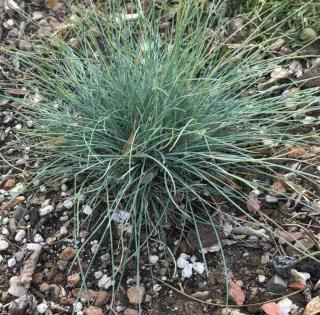 Plant preferably in fall or spring.
Plant preferably in fall or spring.
Avoid periods of freezing to plant, and water regularly during the first weeks after planting, to ensure proper root growth.
You’ll notice that those planted in full sun tend to have stronger blue and silvery hues. They also bloom more. In part shade, leaves are green and blooming is sparse.
As for hardiness, blue fescue can tolerate extreme colds: USDA zone 4 and UK zone H7+. This means it survives the cold down to -30° F (-35° Celsius).
Care is very easy and blue fescue doesn’t require any care at all, except perhaps for watering during sweltering heat and in the first few weeks after planting.
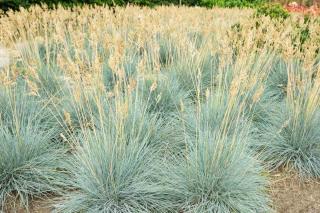 It will grow back after a drought, though it may have to replace all its leaves.
It will grow back after a drought, though it may have to replace all its leaves.
Adaptive to soil of many different types, blue fescue is hardy and fears practically no disease at all. It blooms with tall yellow fronds in early summer.
Pruning it isn’t required, because blue fescue quickly reaches its mature size, and simply keeping it in its natural shape is how it looks nicest.
However, for an older clump, go ahead and cut it back very short at the end of summer. It will grow fresh new fronds during fall. Great to rejuvenate it and give it a few more years of lush growth.
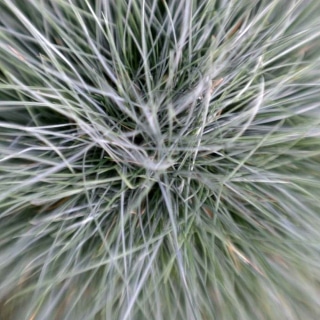 Nothing special to do: your fescue will survive cold weather down to -30° F (and -30°C).
Nothing special to do: your fescue will survive cold weather down to -30° F (and -30°C).
In these cold ranges, foliage will die off, but the root clump will survive and sprout new leaves in spring.
There’s no need to bring your garden boxes indoors for the winter. Quite the contrary, the blue leaves help decorate winter planters very well!
To multiply your clump of blue fescue, simply run a sharp spade along the middle of the clump and pull one half out. This is called crown division.
Blue fescue clumps have an average lifespan of about four years. You can propagate them after that to keep the center lush and green, since older clumps tend to grow sparse in there.
If you aim to cover a field or area, simply let your blue fescue go to seed and it will spread from seed.
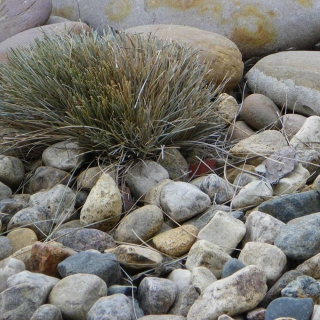 A very cute grass, blue fescue has the advantage of offering very beautiful foliage with steel blue hues, persisting in all seasons.
A very cute grass, blue fescue has the advantage of offering very beautiful foliage with steel blue hues, persisting in all seasons.
Growing it is very easy and it requires practically no care, as for nearly all other types of fescue.
Today, it is one of the favorite grasses for garden decoration and appeals to many with its rarely seen blue tones.
Read also:
These varieties in particular stand out:
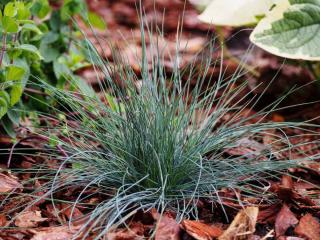 ‘Sea Urchin’: very dense growth, pale blue-green color
‘Sea Urchin’: very dense growth, pale blue-green colorA dwarf blue fescue is the “Tom Thumb”, shown here: it’s only 4 inches tall (10 cm). Perfect for edging in manicured gardens.
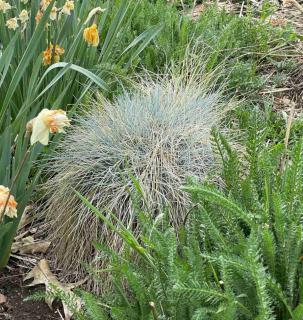 Blue fescue is excellent to add a touch of blue to flower beds.
Blue fescue is excellent to add a touch of blue to flower beds.
Pair blue fescue with mineral mulch for an instant success.